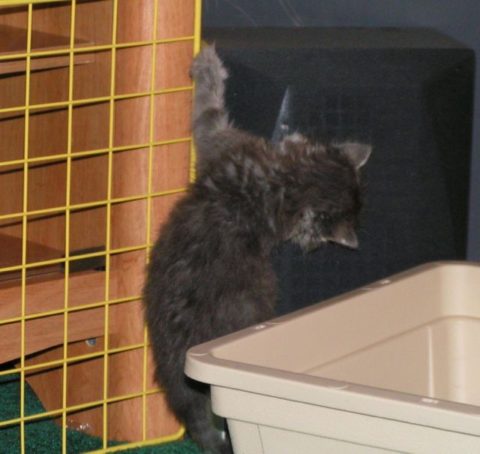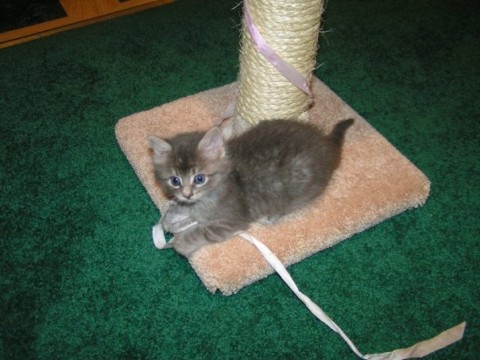Do you have a new kitten, or are you considering getting a new kitten sometime soon? Basically, a kitten is like a small child. Anything she can get into, anything she can play with, anything she can capture, she will. So, before you give kittens the run of your house, you should try to kitten-proof your home as much as possible. This is both for her health and safety and for yours.
Kitten-proof your home by limiting her hiding places
The above picture is Kali when she was about four or five weeks old. She was the risk-taker. The explorer. And if she could find a way out of the pen in which we kept her and Chase, she would. And then she’d hide and we couldn’t find her. We’d tried to kitten-proof, but we didn’t put that speaker and her little claws together as a potential escape route.
So, the first thing you should do to kitten-proof your home is find all the possible hiding places your kitten could use. That includes places like inside the washer and dryer, behind them, under and behind furniture, inside closets, inside cabinets and drawers, and even inside furniture like your sofa or box spring. You kitten might be able to squeeze herself into nooks and crannies you can’t imagine.
Dr. Karen Becker recommends trying to limit her access to these kinds of hiding places as much as possible, especially when you’re not going to be home. This way, not only is she easier to find, but you also lower the risk that she’ll get herself stuck, and possibly seriously injured while trying to get out (this was our biggest worry with Kali). Also, when you’re doing laundry, check the washer and dryer very carefully before closing the door, to be sure she didn’t sneak in under all the clothes. Or just keep her out of your laundry room altogether.
Fragile or breakable items should be put away when you kitten-proof
You will also want to put away things you don’t want knocked over or broken as you kitten-proof, at least until you can teach her where she can and cannot climb. Cats climb, jump, explore, and they want to explore vertically as well as horizontally. Because of this, simply putting things out of reach, as you would for a young child, isn’t likely to work. Case in point – when we first brought Aria in, she jumped from the floor to the top of the mantle above the fireplace, and knocked our wedding goblets off. Of course, one of them shattered. We can replace it, but it’s not quite the same.
Putting these things inside cupboards, drawers and cabinets until she knows where she can and can’t go will help protect these things, and help protect her, too.
Be sure you keep cleaning supplies and anything else that might be toxic to her—like medicines and plants—locked away, or throw them out entirely if you can. She’ll get into anything and everything, especially when you’re not home to stop her.
Choking hazards should also be put away when you go through and kitten-proof
Other things you’ll want to put away, or make inaccessible or unappealing, are dangly things, and things she can swallow or choke on. Ribbons, rubber bands, hair ties, yarn, string, thread, needles, even packing peanuts, can all be dangerous for her. These may be things we don’t often think about, but with a kitten in the house, you should be very careful what you leave out. Put these things inside a latching drawer or cabinet to ensure she can’t get to them
Covering or hiding wires, cords and cables is necessary to kitten-proof your home
Another potential problem is the wires that are all over your house. Kali loves chewing wires. She chews them everywhere – we still haven’t been able to break her of it. So we’ve had to resort to putting things she doesn’t like on the wires because otherwise, she’ll just chew, and chew, and chew.
You can try bundling wires together in plastic tubes, but that may not stop your kitten from chewing them near the outlets. To truly kitten-proof this way, you should put something on the wires themselves that she doesn’t like. Unplugging wires you’re not using will help keep her safe as well.
To keep her away from them altogether, you can put something like Tigerbalm, or Vick’s VapoRub, on the surface of the wire, but test this first. Make sure she really doesn’t like the smell. The last thing you want to do is coat the wire in something she’s just going to lick off and possibly get sick from. Some cats really like menthol, so be sure it’s going to serve as a repellent before using it. This works for Kali, but not for Aria (but Aria’s not a wire-chewer).
You can also put aluminum foil, or something else noisy, down on the floor near the outlets, so she’s startled when she steps on it. The goal here is to make the environment surrounding your wires create negative associations, so she associates bad things with those areas or objects, and not with you.
This can also work for keeping her off the kitchen counters, and off of any furniture you don’t want her climbing. By the same token, you should replace what you’re taking away with acceptable outlets for climbing and chewing. So cat trees, shelves, and toys are a must.
Another kitten-proof method is putting strangling hazards out of reach
You will also want to get things with which she could potentially strangle herself out of reach. Cords on your blinds, and certain fabrics that she could put her head through, can be dangerous for her. In fact, one of our bed skirts has a hole in it, and when Kali was about six weeks old, she put her head through it, and then couldn’t get back out. She panicked and began struggling hard, turning over, and the fabric twisted around her neck. Fortunately I was right there and saw this happen so I was able to free her before she hurt herself.
After that, we tucked the bed skirt up under the mattress so that wouldn’t happen while we were out. To kitten-proof your home in a way that will help you avoid this potential tragedy, you’ll want to coil up cords and hang them on a tack or nail, or the curtain rod. Tuck away fabrics that she could stick her head through.
Finally, eliminating escape routes is a great way to kitten-proof your home
Her natural curiosity to explore will grow, so kitten-proof by blocking off or eliminating her potential escape routes. This applies even if you’re going to let her outdoors, because you don’t want her to slip out unnoticed. Chase once bolted out our back door faster than I was able to react. He only made it to the middle of the yard before he stopped and looked around in wonder, but had he run all the way to the back fence, he could have gone under it and been gone. You may want to consider an outdoor enclosure for her, especially if she just doesn’t seem happy staying inside all the time.




